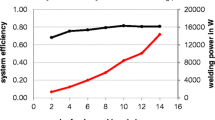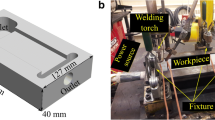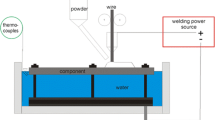Abstract
A study was carried out to measure the effective efficiency of different gas shielded arc welding processes and investigate the role of influence coefficients on the process efficiency. A new system to measure the integrated heat flow in welding processes was developed and further investigated. By this system, it can be shown how e.g. electrical and welding torch parameters, as well as material and gas parameters directly influence the efficiency of the welding process. Through this, it is possible to raise the efficiency of welding (processes for example by reducing the wire speed, using helium gas or increasing the distance of the welding torch to the metal plate. Contrary, increasing the current, welding speed or voltage reduces the process efficiency. The difference between the lowest and highest achievable value of efficiency can be more than 15 % for one specific welding process. In addition to the conventional welding processes like gas tungsten arc welding (GTAW), gas metal arc welding (GMAW) and plasma welding also latest technologies, such as heat reduced processes (for example controlled dip arc with or without wire pullback) and high performance welding processes were analysed. In this manuscript, primarily the new technology for measuring the efficiency is presented. Furthermore, different influence coefficients and their effects on the overall efficiency of welding processes are described. Finally, the differences between measured efficiencies and fixed values of efficiencies for welding processes given in standards are discussed. The efficiencies of the latest heat reduced and high performance welding processes are given. The results verify that the parametrical influence on the efficiency of welding processes is huge, so that it is not recommended to work with fixed efficiency values for example in modeling and simulation.
Similar content being viewed by others
References
DIN EN 1011-1: Welding — Recommendations for welding of metallic materials — Part 1: General guidance for arc welding; German version EN 1011-1:2009.
SEW 088, supplemental sheet 2: Weldable fine grained steels; guidelines for processing, particular for fusion welding, 1993.
Schellhase M.: Der Schweißlichtbogen- ein technologisches Werkzeug (The welding arc, a technological tool), Verlag Technik, Berlin 1985 (in German).
Pepe N. and Yapp D.:Measurements of process efficiency for a range of MIG/MAG welding process, 17th International Conference ComputerTechnology in Welding and Manufacturing, Cranfield, GB, pp. 1–11, 2008.
Shinoda T., Hayashi C. and Kato Y.: Directed plasma fabrication, Proceedings of the International Conference of Materials, Helsingor, DK, pp. 258–267, 2001.
DuPont J.N.: Thermal efficiency of arc welding processes, Welding Journal, vol. 74, pp. 406–416, 1995.
Giedt W. H., Tallerico, L. N. and Fuerschbach P.W.: GTA welding efficiency: calorimetric and temperature field measurements, Welding Journal, vol. 68, pp. 28–32, 1989.
Author information
Authors and Affiliations
Corresponding author
Rights and permissions
About this article
Cite this article
Haelsig, A., Kusch, M. & Mayer, P. New Findings On The Efficiency Of Gas Shielded Arc Welding. Weld World 56, 98–104 (2012). https://doi.org/10.1007/BF03321400
Published:
Issue Date:
DOI: https://doi.org/10.1007/BF03321400




